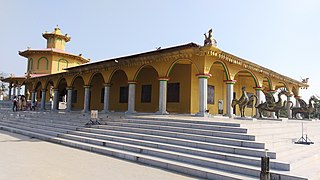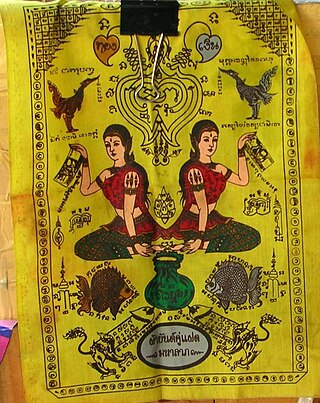
Sacrifice is the offering of material possessions or the lives of animals or humans to a deity as an act of propitiation or worship. Evidence of ritual animal sacrifice has been seen at least since ancient Hebrews and Greeks, and possibly existed before that. Evidence of ritual human sacrifice can also be found back to at least pre-Columbian civilizations of Mesoamerica as well as in European civilizations. Varieties of ritual non-human sacrifices are practiced by numerous religions today.

Animal sacrifice is the ritual killing and offering of one or more animals, usually as part of a religious ritual or to appease or maintain favour with a deity. Animal sacrifices were common throughout Europe and the Ancient Near East until the spread of Christianity in Late Antiquity, and continue in some cultures or religions today. Human sacrifice, where it existed, was always much rarer.

Kaharingan is an indigenous monotheistic folk religion of the Dayak people such as Katingan, Lawangan, Ma'anyan, Ngaju, Ot Danum people native to the Central Kalimantan and South Kalimantan region in Indonesia.

Shugendō is a highly syncretic religion, a body of ascetic practices that originated in the Nara Period of Japan having evolved during the 7th century from an amalgamation of beliefs, philosophies, doctrines and ritual systems drawn from local folk-religious practices, Shinto mountain worship and Buddhism. The final purpose of Shugendō is for practitioners to find supernatural power and save themselves and the masses by conducting religious training while treading through steep mountain ranges. Practitioners are called Shugenja or Yamabushi. The mountains where shugendo is practiced are all over Japan, and can span multiple mountains within one range such as the Ōmine mountain range with Mount Hakkyō and Mount Ōmine or the Ishizuchisan mountain range with Kamegamori and Tengudake.
The Navajo song ceremonial complex is a spiritual practice used by certain Navajo ceremonial people to restore and maintain balance and harmony in the lives of the people. One half of the ceremonial complex is the Blessing Way, while the other half is the Enemy Way.

The Aztec religion is a polytheistic and monistic pantheism in which the Nahua concept of teotl was construed as the supreme god Ometeotl, as well as a diverse pantheon of lesser gods and manifestations of nature. The popular religion tended to embrace the mythological and polytheistic aspects, and the Aztec Empire's state religion sponsored both the monism of the upper classes and the popular heterodoxies.

There are several styles of classical and folk dance in Sri Lanka.
Maya medicine concerns health and medicine among the ancient Maya civilization. It was a complex blend of mind, body, religion, ritual and science. Important to all, medicine was practiced only by a select few, who generally inherited their positions and received extensive education. These shamans acted as a medium between the physical world and spirit world. They practiced sorcery for the purpose of healing, foresight, and control over natural events. Since medicine was so closely related to religion, it was essential that Maya medicine men had vast medical knowledge and skill.

In the cultures of the Horn of Africa and adjacent regions of the Middle East, Zār is the term for a demon or spirit assumed to possess individuals, mostly women, and to cause discomfort or illness. The so-called zār ritual or zār cult is the practice of reconciling the possessing spirit and the possessed individual. Zār possession is often considered lifelong and the rituals associated with it are a form of adorcism, though some have falsely attributed it as an exorcism rite because it involves possession. It is similar to the Maghreb's Hamadsha, Hausa Animism, and various African Traditional religions, such as Voodou.
The Luvale people, also spelled Lovale, Balovale, Lubale, as well as Lwena or Luena in Angola, are a Bantu ethnic group found in northwestern Zambia and southeastern Angola. They are closely related to the Lunda and Ndembu to the northeast, but they also share cultural similarities to the Kaonde to the east, and to the Chokwe and Luchazi, important groups of eastern Angola.
Devotion, a central practice in Buddhism, refers to commitment to religious observances or to an object or person, and may be translated with Sanskrit or Pāli terms like saddhā, gārava or pūjā. Central to Buddhist devotion is the practice of Buddhānussati, the recollection of the inspiring qualities of the Buddha. Although buddhānussati was an important aspect of practice since Buddhism's early period, its importance was amplified with the arising of Mahāyāna Buddhism. Specifically, with Pure Land Buddhism, many forms of devotion were developed to recollect and connect with the celestial Buddhas, especially Amitābha.
The Arrow of Brahma is from Hindu writings. It is also an implement in a ritual of the Theravada Buddhists.

The Tai folk religion, Satsana Phi or Ban Phi is the ancient native ethnic religion of Tai people still practiced by various Tai groups. Tai folk religion was dominant among Tai people in Asia until the arrival of Buddhism and Hinduism. It is primarily based on worshipping deities called Phi, Khwan and Ancestors.
Pagtatawas is a divination ritual in pseudomedicine in Filipino Psychology, carried out by the mangtatawas. It attempts to diagnose an affliction or psychological disorder by interpreting shapes produced in water by heated alum or molten wax droppings from a burning candle. It is thus a form of both carromancy and oryctomancy.
This is the glossary of Shinto, including major terms on the subject. Words followed by an asterisk (*) are illustrated by an image in one of the photo galleries.

Sanni yakuma, sometimes known as Daha ata sanniyas, is a traditional Sinhalese exorcism ritual. The ritual consists of 18 masked dances, each depicting a particular illness or ailment affecting humans. These 18 dances are the main dances of the Pahatharata, or low country, dancing form, which is one of the three main dancing forms of Sri Lanka. The ritual calls the demons who are thought to affect the patient, who are then told not to trouble humans and banished.

Yamurikuma is a female spirit who represents the ancestral women of the indigenous Wauja people. The Wauja people are located at South America, in the Upper Xingu River, Brazil. Wauja people have celebrated Yamurikuma in rituals, ceremonies, and traditions for centuries. Shamans in Xingu villages call women specifically to perform sing and song rituals for the female spirit Yamurikuma and the deceased or terminally ill Xingu people. It is one of the only exceptions made for the women in these communities to lead a ritual. Yamurikuma is also celebrated in a festival named after the spirit herself. This festival is organized by the Xingu Tribes, and throughout this specific festival, the Xingu women take on the male roles of the tribe for a week.

Thai folklore is a diverse set of mythology and traditional beliefs held by the Thai people. Most Thai folklore has a regional background for it originated in rural Thailand. With the passing of time, and through the influence of the media, large parts of Thai folklore have become interwoven with the wider popular Thai culture.

During the pre-Columbian era, human sacrifice in Maya culture was the ritual offering of nourishment to the gods and goddesses. Blood was viewed as a potent source of nourishment for the Maya deities, and the sacrifice of a living creature was a powerful blood offering. By extension, the sacrifice of human life was the ultimate offering of blood to the gods, and the most important Maya rituals culminated in human sacrifice. Generally, only high-status prisoners of war were sacrificed, and lower status captives were used for labor.
Ceremonies of Ancient Greece encompasses those practices of a formal religious nature celebrating particular moments in the life of the community or individual in Greece from the period of the Greek dark ages to the middle ages. Ancient Greek religion was not standardised and had no formalised canon of religious texts, nor single priestly hierarchy, and practices varied greatly. However, ceremonial life in pre-Christian Greece generally involved offerings of a variety of forms towards gods and heroes, as well as a plethora of public celebrations such as weddings, burial rites, and festivals.











